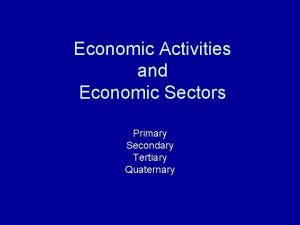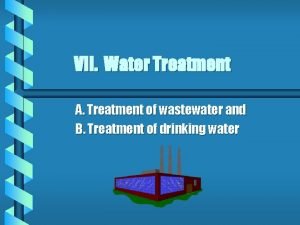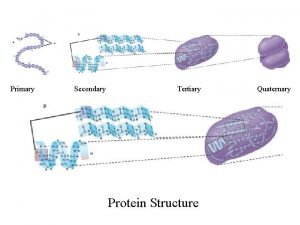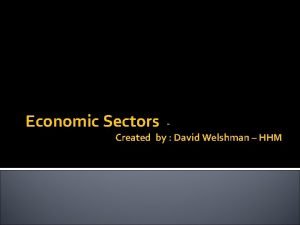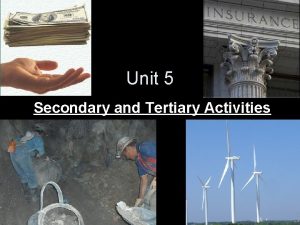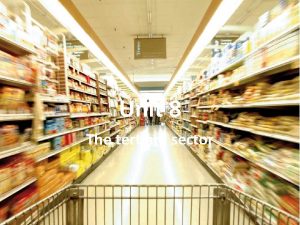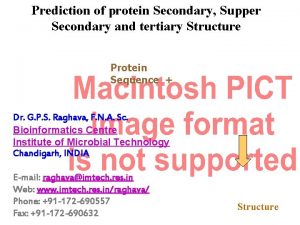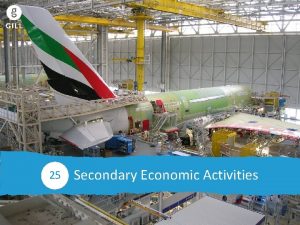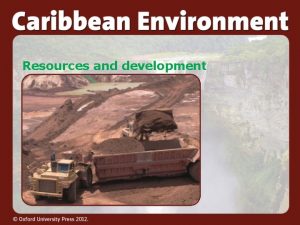Unit 5 Secondary Tertiary Activities Introduction Introduction Three















- Slides: 15

Unit 5: Secondary & Tertiary Activities Introduction

Introduction: Three Sectors of the Economy n This particular lesson deals with secondary processing or manufacturing. However it is useful to have a perspective for where manufacturing fits in the whole economy. The three main sectors of any economy are briefly outlined below and as you can see manufacturing is the secondary economic activity.

Primary Economic Activity • • involves the collection of raw materials from the earth. all involve collecting natural resources.

Primary …. . . Farming, fishing, mining, forestry are the classic parts of the primary economy. The farmer takes plants from the land, the forester takes trees from the forest, the fisher takes fish from the ocean and the miner takes ore from the ground.

Secondary Economic Activity n involves processing or manufacturing raw materials into products for people to buy. It is often referred to as the manufacturing or processing sector.

Secondary … n n . . . the cows are butchered into roasts, steaks and ground beef and packaged for sale at the grocery store; the trees are milled into lumber or pulped into paper; the fish are gutted, filleted, and frozen for market; while the ore is refined as well.

Secondary … n n All examples for secondary processing start with a raw material and convert it to a product for sale. This is referred to as Value Adding.

Secondary … n . . . the tree would be much less expensive to buy than the lumber. The lumber has value added. Ship building, is an example of the manufacturing sector.

Tertiary Economic Activity n n does not involve raw materials, rather it involves providing service to people. it is often referred to as the service industry. Nurses, doctors, lawyers, teachers, waitresses, hairdressers, sales people all provide services for other people. Tourism is an important part of the tertiary sector {golf has become a thrust for investment in Newfoundland & Labrador. }

The Language of Manufacturing n Inputs = materials & factors that go into making a product. … raw material, power, buildings, land, labor, decisions, capital, machinery. n Outputs = finished product from a manufacturing process. …the output from the fish plant is fish sticks or frozen fish fillets.

Three types of manufacturing processes n n Conditioning = minimal change to a resource. … logs into lumber; fish into fillets. Analytical = resource converted to a number of different products. … cow into leather, milk & cheese n Synthetic = several resources are combined to make one resource. … light bulb has glass, tungsten, Nitrogen & aluminum.

Profit & manufacturing Profit is: n the difference between the price charged for the product and the money spent in manufacturing, shipping and selling the product.

Profit … n Manufacturing businesses are in the business of value adding so they must consider the cost of adding value.

Profit … n n n Labor is often the most expensive part of an operation. wages, CPP, EI, Pensions, Sick days, Holidays etc. The cost of raw material is an important factor to consider and the difficult thing for manufacturers is that the price of materials vary with the markets. The cost of equipment and utilities must also be considered.

Profit … n n n Training costs money but is important to increased efficiency and quality of product. High volume products, like pop, can have a low profit margin; while low volume products like Jewelry require a high profit margin. In any event for manufacturers to turn a profit their product must meet market demands.
 Primary activities definition
Primary activities definition Quaternary economic activities
Quaternary economic activities Tertiary economic activities
Tertiary economic activities Paris basin population
Paris basin population Types of tertiary activities
Types of tertiary activities Wastewater treatment process primary secondary tertiary
Wastewater treatment process primary secondary tertiary Primary secondary tertiary colors
Primary secondary tertiary colors Oxidation of primary alcohols
Oxidation of primary alcohols Tertiary sources
Tertiary sources Primary secondary tertiary
Primary secondary tertiary Levels of health care primary secondary tertiary
Levels of health care primary secondary tertiary Food web
Food web Ubiquitous ap human geography
Ubiquitous ap human geography Primary processing
Primary processing Education level primary secondary tertiary malaysia
Education level primary secondary tertiary malaysia Primary secondary and tertiary sector
Primary secondary and tertiary sector

